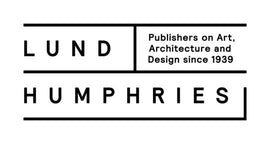Design for the Corporate World
Architectural, industrial, and graphic design in the United States from the 1950s through to the 1970s – generally known as mid-century modern – is now perceived as a golden era, with artists such as Charles and Ray Eames, Eero Saarinen, and Eliot Noyes having become household names.
We are delighted to be publishing Design for the Corporate World, 1950–1975, edited by Wim de Wit (HB £35 RRP) this Spring, in association with Cantor Arts Center, University of Standford, to accompany a major exhibition on view 26 April-21 August 2017.
The book and exhibition present a fascinating new perspective on the creation and production of mid-century modern design. Creativity on the Line: Design for the Corporate World, 1950–1975 explores the groundbreaking work of major American designers such as Eliot Noyes and Paul Rand (for IBM and Westinghouse), Charles and Ray Eames (for Herman Miller) and Ivan Chermayeff (for Mobil Oil). European designers, including Ettore Sottsass and Marcello Nizzoli (for Olivetti) and Dieter Rams (for Braun), are also represented.
The beautifully illustrated book looks at the relationship between these designers and the companies who employed them, highlighting the political, social and cultural circumstances in which seminal design icons such as the Selectric Typewriter for IBM and the distinctive Westinghouse Electric Manufacturing Company logo were created. Quotes are extensively used to illustrate the designers’ fear of “selling out” to commerce.
Here we’ve chosen some of our favourite examples of design classics, taken from the book.
![[CP 006 nastri dattilografici Olivetti] 2008](https://modernbritishartists.files.wordpress.com/2017/03/cp-006-nastri-dattilografici-olivetti-2008.jpg?w=461)
Ing. C. Olivetti & C., Poster
advertising “nastri dattilografici
(typewriter ribbons) ICO Olivetti”,
c.1950.
Lithograph mounted on canvas.
71.12 x 50.8 cm (28 x 20 in).
San Francisco Museum of
Modern Art.

Eliot Noyes, IBM Selectric
Typewriter, 1961.
Molded aluminum.
Photo: Bertrand Prévost.
Musée National d’Art
Moderne, Paris. Courtesy
of International Business
Machines Corporation,
© 1961 International
Business Machines
Corporation.
![[CP 021 Beall style book CT Gen'l Ins]cc20160825_Beall_0775](https://modernbritishartists.files.wordpress.com/2017/03/cp-021-beall-style-book-ct-genl-inscc20160825_beall_0775.jpg?w=461)
Lester Beall, Connecticut
General Style Book, 1958.
A style book instructs a
company’s employees on how
to use a logo on letterhead,
business cards, and even on
buildings.
Print on coated heavy paper.
22.8 x 23.4 cm (9 x 9 ¼ in).
![[CP 017 Bradford, Sewage Treatment] r697648_2007_m_7_ff001_001_3000x3000](https://modernbritishartists.files.wordpress.com/2017/03/cp-017-bradford-sewage-treatment-r697648_2007_m_7_ff001_001_3000x3000.jpg?w=461)
Peter Bradford, “Sewage
Treatment,” poster
designed in conjunction
with the twenty-second
IDCA conference,
The Invisible City, 1972.
Print on coated paper.
88.1 x 61.2 cm (34 11⁄16 x
24 1⁄8 in).
![[CP 027 Noyes Westinghouse Pavilion 1964] 2006](https://modernbritishartists.files.wordpress.com/2017/03/cp-027-noyes-westinghouse-pavilion-1964-2006.jpg?w=461)
Eliot Noyes, Model for the
Westinghouse Pavilion
at 1964 New York World’s
Fair, 1961, not built.
Painted wood, unknown
plastic, and PMMA.
20.32 x 81.28 x 64.14 cm
(8 x 32 x 25 ¼ in).
![[CP 011 Booklet 7th Conf IDCA] r697648_910009_b021_f010_001_3000x3000](https://modernbritishartists.files.wordpress.com/2017/03/cp-011-booklet-7th-conf-idca-r697648_910009_b021_f010_001_3000x3000.jpg?w=461)
Designer unknown, Proceedings
of the seventh IDCA conference,
1957.
Print on thin paper stock.
18.4 x 36.8 cm (7 ¼ x 14 ½ in).

Design for the Corporate World 1950-1975, edited by Wim de Wit, is published April 2017, Hardback £35.
The book includes scholarly essays that expand on subjects related to the exhibition’s main theme. An essay by Wim de Wit, Adjunct Curator of Architecture and Design at the Cantor Arts Center and curator of the exhibition, examines the ambivalence of graphic and industrial designers in their relations with the corporate world. Contributor Greg Castillo, Associate Professor of Architecture in the College of Environmental Design at UC Berkeley, places the work of post-war designers in the larger cultural and political context of the Cold War and of the developing counterculture of the late 1960s and early ’70s.
Louise Mozingo, Professor and Chair of Landscape Architecture & Environmental Planning and Urban Design in the College of Environmental Design at UC Berkeley, writes about corporate directors who hired prominent architects to make their office buildings look modern, but then asked landscape designers to soften the seemingly stark architectural effect.
The book concludes with an essay by Steven McCarthy, Professor in the College of Design at the University of Minnesota, about design education at Stanford University in the post-war period. Profiles of the major designers and corporations represented in the exhibition are also included.
Buy your copy of Design for the Corporate World 1950-1975 here.

